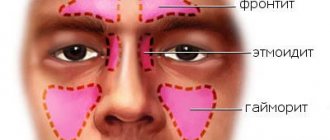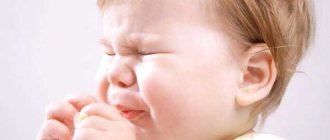According to doctors, it is easier to prevent any disease than to treat it later. First of all, this concerns childhood inflammatory and cold diseases, so the prevention of acute bronchitis in babies and older children is an important measure that helps to avoid serious problems with children's health.
Timely and adequate preventive measures can save a child from serious complications and suffering. Modern official medicine, numerous recipes for alternative medicine and the accumulated experience of pediatricians have a solid arsenal of various remedies. In most cases, they will help prevent a child with a common cold from developing complications in the form of acute bronchitis.
How does childhood acute bronchitis occur?
Acute bronchitis in children is a fairly severe inflammation in the bronchi. It develops and progresses as a result of their irritation and swelling. The inflammatory process usually increases if no measures are taken to treat the sick child.
IMPORTANT! Acute bronchitis especially often affects children, since it is their fragile organisms and immunity that are still in the development stage and do not always have time to cope with the invasion of viruses and bacteria.
Acute bronchitis in children is most often caused by the following reasons:
- penetration and reproduction in the nasopharynx and bronchi of influenza viruses, adenoviruses and other types of infectious viruses;
- infection of a child with bacteria of staphylococci, streptococci, pneumococci, etc.;
- various unfavorable physical and chemical factors.
The following circumstances also contribute to the appearance of acute bronchitis:
- Hypothermia of a child.
- Passive smoking, when the baby constantly breathes air in a smoky room.
- Chronic infections up to caries and constant inflammatory processes in the nasopharynx.
- Weak immunity.
- Disruption of normal nasal breathing due to adenoids or a deviated nasal septum.
- Congenital or acquired deformity of the chest.
In healthy children, the air that passes through the bronchial tree to the lungs is practically free of any harmful microorganisms. The air is filtered due to the fact that:
- the mucous membrane of the nasopharynx cleanses the air of all bacteria and microbes that enter with breathing;
- The baby's cough reflex also helps clear the air;
- The filtration process is completed by microscopic cilia that dot the bronchial mucosa.
However, when certain circumstances occur, some of which are listed above, microbes, viruses or negative chemicals still penetrate the children's bronchi and cause various disorders and damage in them. Disturbances are accompanied by inflammatory processes, increased production of bronchial mucus and intense cough. A viral infection in children that has reached the bronchi quickly irritates and damages the upper area. Some of them provoke the acute course of the disease.
Is obstructive bronchitis contagious?
Most children with obstructive bronchitis are contagious if the cause is an infectious agent such as a virus or bacteria. The infectious period for bacteria and viruses usually lasts as long as the patient has symptoms, although some viruses will be contagious for several days before symptoms appear. Contagious viruses that cause obstructive bronchitis are listed in the causes section.
Contagiousness subsides when symptoms subside. But bronchitis caused by exposure to pollutants, cigarette smoke, or other environmental substances is not contagious.
Prevention of acute bronchitis in children
The complication of acute bronchitis in a child can be prevented. Or try to prevent the protracted nature of his treatment.
First of all, the prevention of acute bronchitis in children consists of protecting the throat and legs during the cold season. But it is not necessary to wrap your baby up excessively in winter. When moving, the child will overheat and sweat, which will result in a cold. And, as an option, the appearance of acute bronchitis.
IMPORTANT! Those children who are often exposed to bronchitis, sore throats and nasopharyngeal diseases will definitely benefit from hardening. It stimulates the hidden capabilities of the child’s body and mobilizes its protective forces at the time of the onset of unfavorable circumstances.
As a simple and effective measure to prevent illness in a child, you can use hardening of the feet using foot baths. This disease prevention should be carried out in children over 3 years of age. Foot baths should be done daily and should start with a water temperature of about 25 degrees Celsius. Every week the temperature can be reduced by 2-3 degrees. Ultimately, it should correspond to 12-15 degrees Celsius. After each procedure, the child’s feet must be thoroughly rubbed until the skin becomes slightly red.
Types of disease
According to the characteristics and duration of the disease, there are the following varieties:
- Acute bronchitis. The most common type of bronchitis, which with proper treatment goes away quickly and leaves no complications. On average it lasts from one and a half to three weeks, depending on the severity of the course.
- Recurrent bronchitis. We can talk about it if a child suffers from bronchitis three or more times a year.
- Chronical bronchitis. If a child systematically develops bronchitis over the course of two years, and the cough is observed for at least three months a year, we can talk about chronic bronchitis. Long-term chronic bronchitis is fraught with severe complications, including lung cancer.
Depending on the severity of the disease, there are:
- mild bronchitis;
- average;
- heavy.
Depending on the etiology, there are:
- Infectious bronchitis. Caused by pathogenic microorganisms.
- Allergic bronchitis. Associated with the body's reaction to certain allergens.
- Bronchitis of unspecified etiology. Displayed if doctors were unable to determine what exactly caused the disease.
If a child has bronchospastic syndrome (bronchial spasms, problems with ventilation in the lungs), bronchitis is called obstructive , but if it is absent, then non-obstructive .
Prevention algorithm
Also, prevention of acute bronchitis in children includes the following actions:
- The child should have a daily routine appropriate for his age. It should include proper rest, regular walks in the fresh air, and sound sleep during the day and night.
- Any person, and especially a child, needs plenty of fluids. Drinking enough fluids helps prevent detoxification of the child's body during a cold. The water temperature should correspond to the baby's body temperature.
- The air in the room where the child sleeps and plays should be cool and sufficiently humid. It is advisable to maintain the air temperature at 20 degrees Celsius, and humidity at about 70%.
- If parents are concerned about their child's weak immunity, they should consult a pediatrician. What preventive measures should be used to boost the child’s body’s defenses? Doctors recommend giving children vitamins, selecting healthy foods, and making them healthy at sea every year.
- An important point in the prevention of acute bronchitis is compliance with the childhood vaccination schedule. They will protect the baby from diseases that could potentially cause bronchitis, in particular whooping cough, measles, etc.
- It is imperative to protect your child from exposure to tobacco smoke and harmful chemical fumes, especially during home renovations.
Causes
The main reasons for the development of various forms of bronchitis:
- Entry of pathogenic microorganisms into the bronchi area. Most often, bronchitis is caused by viruses, less often by bacteria, fungi and other pathogens. They are involved in the occurrence of almost all types of bronchitis.
- Contact with allergens. Various substances that are normally safe act as allergens. An allergic reaction in a child most often occurs to food products, animal hair, dust, household chemicals, and pollen.
- Being among a large number of children. Kindergartens and schools are places where children are crowded, so the spread of infection accelerates many times. It is important to strengthen the child’s immunity in the autumn-winter period and not send him to school or kindergarten if he has symptoms characteristic of respiratory diseases.
- Poor living conditions at home. Cockroaches, mice, and rats are sources of allergens and carriers of pathogenic microorganisms. Dirt, clutter, poor heating of rooms, and cigarette smoke (including passive inhalation) also have an adverse effect.
- Poor quality treatment of respiratory diseases, lack of treatment. If a child falls ill with the flu, acute respiratory viral infection or acute respiratory infection and does not receive the necessary treatment, his illness becomes more complicated: bronchitis, pneumonia occurs, and the functioning of many organs and systems is disrupted. Also, complications cannot be avoided if parents treat their child with dubious traditional methods and do not go to the hospital.
- Stress, neuroses. Children who systematically find themselves in stressful situations (quarrels with parents, divorce of mother or father, humiliation at school, difficulties in building social connections, death of loved ones or pets, increased mental or physical stress) are more likely to get sick.
- Chronic diseases of the upper respiratory tract , such as tonsillitis, sinusitis. Pathogenic microorganisms persist for a long time in the body and can lead to various complications, including bronchitis.
Bronchitis also occurs more often in children with a history of birth injuries, congenital anomalies of the respiratory organs, and prematurity.
Prevention of runny nose and throat diseases
It should be remembered that in many children acute bronchitis begins with a simple runny nose. If the child’s parents act ineptly, a runny nose leads to infection in the throat and then into the bronchi. Starting from 6-7 years of age, ENT doctors recommend hardening and cleansing the child’s nasopharynx.
For many children, nasal hardening is an unpleasant procedure, so its effectiveness and benefits should be explained to the child. First, you need to teach your baby to rinse his nasal passages with warm water. To do this, use a pipette to instill a few drops of lukewarm water into both nostrils and draw the water into yourself as you inhale. For convenience, you can tilt your head back.
After the child learns how to rinse and the nasal passages get used to warm water, you can prepare a cooler liquid for the baby and increase the number of drops in each passage. Also, the child’s throat is washed along with his nose, which is also an effective measure to prevent the disease.
To prevent acute bronchitis, you should protect your child from many negative and dangerous factors, but at the same time, you should not protect him too much from the effects of the outside world. Advice from a pediatrician, reasonable hardening, a healthy lifestyle for the child and other methods of prevention will strengthen the child’s body’s resistance to all viral and colds, including acute bronchitis.
Complications
The most common complication of acute bronchitis is pneumonia , which is extremely dangerous for young children.
In the absence of quality treatment, acute bronchitis becomes recurrent, which is much more difficult to cure completely.
Recurrent bronchitis , if no action is taken, becomes chronic, which can eventually lead to diseases such as:
- chronic obstructive pulmonary disease;
- pulmonary emphysema;
- pneumosclerosis;
- pulmonary heart;
- Lung cancer is the most common cancer.
Allergic bronchitis can cause the development of bronchial asthma: a dangerous disease that significantly increases the likelihood of developing anaphylactic shock upon contact with an allergen, which can lead to suffocation and death.
Diagnostics
If a child shows signs of bronchitis, he should be shown to a pediatrician, who will conduct a basic examination, ask questions, give a referral to a pulmonologist, who will make a diagnosis based on symptoms and diagnostic results, and, if necessary, to an allergist.
Analyzes and research:
- sputum culture to identify pathogens (bacterial culture, PRC and others);
- clinical analysis of urine and blood;
- X-rays of light;
- determination of tidal volumes;
- bronchography;
- blood gas composition.
If the allergic nature of the disease is suspected, tests are carried out to determine the allergen: skin prick testing, patch test, and detection of the concentration of immunoglobulin E in the blood.
If necessary, additional studies may be indicated to determine the condition of other organs and systems.
Komarovsky's opinion
Dr. Komarovsky believes that bronchitis in 99% of cases is caused by viruses, so prescribing antibiotics is inappropriate.
Recommendations for care from Dr. Komarovsky:
- the child should be given plenty of fluids to improve sputum discharge;
- the air in the child’s room should not be dry and too hot;
- it is important to regularly ventilate the room;
- Massage should be done to speed up the discharge of sputum (not possible if the child has a fever).
Massage option : the child is placed so that his chest is below the pelvis. After this, you need to tap on his back, abruptly sit him upright and ask him to cough.











